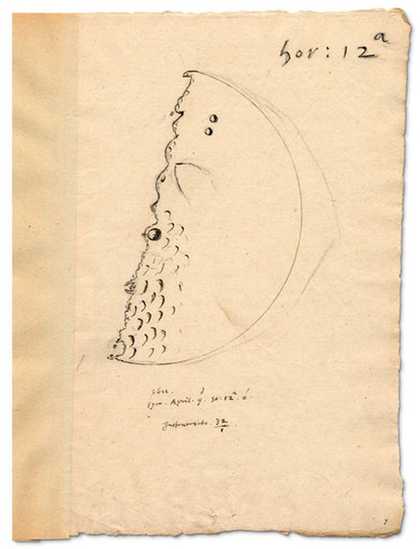
Thomas Harriot
Drawing of the moon 1611
Courtesy Lord Egremont/Galaxy Collection, West Sussex Record Office
An instrument can change the world and compel us to rethink our place in the universe. The telescope did just this, but only when it was used by someone whose eye was prepared to see new things and whose hand was able to depict what he saw. A case in point is Thomas Harriot (1560–1621), who was the first to use a telescope to look at the moon, but only grasped that it was covered with mountains and craters after he saw Galileo’s rendering of the lunar surface. The reason that Galileo (1564–1642) was more successful is that he brought art to the aid of science.
The telescope, invented around 1590 in Italy, was initially a crude device that enlarged four or five times and was little more than a plaything. The Dutch reinvented the instrument a few years later and began selling it all over Europe. Harriot heard about it and skilfully combined a couple of lenses to make objects appear six times closer. On 26 July 1609 he looked at a five-day-old crescent moon as we can see in the sketch that he made. He clearly saw that the line separating the illuminated part from the dark side is ragged and uneven, when it should have appeared smooth and continuous if the surface of the moon had been perfectly round like a crystal ball. A month later, Galileo made a similar instrument and started to observe the moon. He had two advantages over Harriot. The first is that he lived in Padua, some 30 kilometres from the island of Murano, famous to the present day for the quality of its glasswork. The local artisans were particularly good at making lenses for near-sighted and long-sighted people, and Galileo selected a number that looked promising. He played around with them, and within a few weeks he had fitted a couple together to make a telescope that magnified not six but fifteen times. The second and decisive advantage is that he had learned about perspective and knew how different combinations of light and shadow reveal whether a distant landscape is flat or mountainous.
It is sometimes said that Galileo always wanted to be a professor, but this is wrong. He wanted to be a painter, and dropped out of the University of Pisa before taking a degree in order to become an artist. He went to a Florentine art school where he made friends with several fellow students who later became famous painters, and with whom he stayed in contact all his life. He left the art school (dropped out again) not because he did not have the makings of a painter, but because his father, an impoverished musician, told him there was no money to be had in the art world without the right connections. Since Galileo was good at mathematics, his father urged him to get a safe job as a maths teacher. He complied, but, to his dying day, regretted not having followed his calling as an artist.
I believe that without the unknown and unsung craftsmen of Murano, who made the lenses that he needed, and without his training as a painter, Galileo would never have achieved his lasting fame as the Columbus of the new heavens. It was because he had the eye of an artist that he correctly interpreted the interplay of light and shadow on the moon as indicating that it was covered with mountains and craters and, hence, that it resembled the earth. This was exciting news, because if the moon was like the earth, then it could be inhabited!
Galileo published his celestial observation, Sidereal Messanger, in Venice on 13 March 1610, and on that very day a copy was purchased and sent to London by the British ambassador, Sir Henry Wotton. The book was passed on to Thomas Harriot, who was struck by one of Galileo’s illustrations, which shows a large crater just below the centre of the moon when it is in its first phase. When he looked once again at the moon, he observed this striking feature that had escaped him a year earlier, and the result was the sketch he made on 17 July 1610. The moral, if any, is that we see what we expect to see.
Harriot was not a man to blow his own trumpet and never published any of his important telescopic observations of the moon, the sunspots or the planets. These remained unknown until 1784 when they were found under stable accounts, and were not published until 1833. It is one of the ironies of history that Harriot could have had someone draw the moon as he saw it through his telescope. He had been on voyages of exploration and knew from first-hand experience how important drawings can be. Sir Walter Raleigh, who planned to establish a colony in the New World and in 1585 sent 109 would-be colonists to Roanoke Island (now North Carolina), employed him to carry out a survey of the animals and the natural products, gather information about the life and customs of the natives, and create maps of the area. He was joined by John White, a gentleman-artist, and together they travelled up and down the coast, documenting what they found. What Harriot wrote, White brought to life in a series of watercolours that are truly spectacular, many of which survive in the British Museum. The painter had a quick eye and worked speedily to jot down the unfamiliar. So one wonders what might have happened if he had been able to record the features of the moon that Galileo noticed. It is a great pity that White was not standing next to Harriot when, for the first time in human history, he raised his telescope to the sky.
